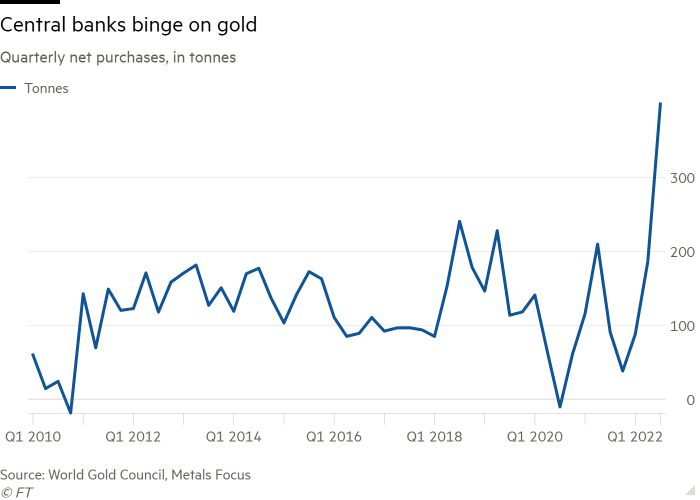Central banks are scooping up gold at the fastest pace since 1967, with analysts pinning China and Russia as big buyers in an indication that some nations are keen to diversify their reserves away from the dollar.
Data compiled the World Gold Council, an industry-funded group, has shown demand for the precious metal has outstripped any annual amount in the past 55 years. Last month’s estimates are also far larger than central banks’ official reported figures, sparking speculation in the industry over the identity of the buyers and their motivations.
The flight of central banks to gold “would suggest the geopolitical backdrop is one of mistrust, doubt and uncertainty” after the US and its allies froze Russia’s dollar reserves, said Adrian Ash, head of research at BullionVault, a gold marketplace.
The last time this level of buying was seen marked a historical turning point for the global monetary system. In 1967, European central banks bought massive volumes of gold from the US, leading to a run on the price and the collapse of the London Gold Pool of reserves. That hastened the eventual demise of the Bretton Woods System that tied the value of the US dollar to the precious metal.
Last month the WCG estimated the world’s official financial institutions have bought 673 tonnes. And in the third quarter alone central banks bought almost 400 tonnes of gold, the largest three-month binge since quarterly records began in 2000.
The conservative estimates from the WGC outstrip the reported purchases to the IMF and by individual central banks, which stands at 333 tonnes in the nine months to September.
Officially, the buying in the third quarter was led by Turkey at 31 tonnes, taking gold to about 29 per cent of its total reserves. Uzbekistan followed with 26 tonnes, while in July Qatar made its largest monthly acquisition on record since 1967.
The discrepancy between the WGC’s estimates and officially reported figures tracked by the IMF can be partly explained by government agencies besides the central banks in Russia, China and others that can buy and hold gold without reporting them as reserves.

Acknowledging its intake — but also possibly trying to signal its limited role — the People’s Bank of China (PBoC) reported earlier this month that in November it made its first increase in gold holdings since 2019, with a 32-tonne bump worth about $1.8bn. Yet the gold industry says Chinese buying is almost certainly higher.
Mark Bristow, chief executive of Barrick Gold, the world’s second-largest gold miner, said China had bought tonnes of gold around the high-200s mark, based on his discussions with numerous sources.
Nicky Shiels, metals strategist at MKS PAMP, a precious metals trading company, added gold prices would have peaked around $75 lower in November if the PBoC had only purchased 32 tonnes. Gold prices traded as high as $1,787 a troy ounce in November and have since advanced above $1,800.
For Russia, sanctions have created significant problems for its gold mining industry — the largest in the world after China — in selling overseas. It produces roughly 300 tonnes each year but has a domestic market for only 50 tonnes, according to MKS PAMP.
At the same time, western governments have frozen $300bn of Russia’s foreign currency reserves through sanctions, which Shiels says has prompted nations outside the west to ask: “Should we have exposure to so many dollars when the US and western governments can confiscate that at any time?”
Russia’s gold-buying repeats South Africa’s playbook during Apartheid-era sanctions of supporting domestic mining by buying the yellow metal using local currency, says Ash.
“With limitations on the export side, it would make sense it’s the Russian central bank,” said Giovanni Staunovo, commodity analyst at UBS.
The Central Bank of Russia stopped reporting monthly numbers on its reserves soon after the war began. CBR officials have rejected the suggestion it is buying gold.
“Our gold and foreign exchange reserves are sufficient. We don’t have a specific task of accumulating gold and foreign exchange reserves,” said CBR governor Elvira Nabiullina in mid-December.
Yet CBR officials have long placed strategic value on boosting gold reserves; in 2006 it said it would be desirable for gold to make up 20-25 per cent of its holdings — in February 2022, the last time CBR published its statistical data, gold accounted for 20.9 per cent. It has reduced its holdings of US Treasuries to only $2bn from more than $150bn in 2012, while increasing gold reserves by more than 1,350 tonnes worth almost $80bn at current prices, according to Julius Baer, a Swiss private bank.
Carsten Menke, head of next generation research at Julius Baer, reckons the purchases from Russia and China indicate a growing reluctance for countries to rely on the greenback.
“The message these central banks are sending by putting a larger share of their reserves in gold is that they don’t want to be reliant on the US dollar as their main reserve asset,” Menke said.
Some in the industry speculate Middle Eastern governments are using fossil fuel export revenues to buy gold, most likely through sovereign wealth funds.
The coming months will test whether record central bank buying was an opportunistic spurt as gold prices fell, or a more structural shift.
Even with prices having since recovered to about $1,800 per troy ounce, few are willing to bet the trend towards diversification of central bank reserves will change course any time soon.
Bernard Dahdah, senior commodities analyst at Natixis, the French investment bank, said deglobalisation and geopolitical tensions meant the drive by central banks outside of the west to diversify away from the US dollar was “a trend that won’t change for a decade at least”.
Additional reporting by Anastasia Stognei in Riga


Comments are closed, but trackbacks and pingbacks are open.